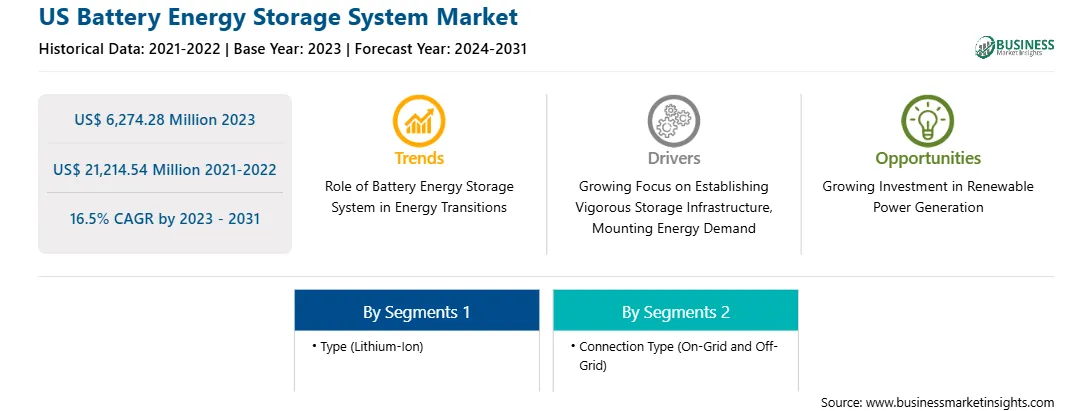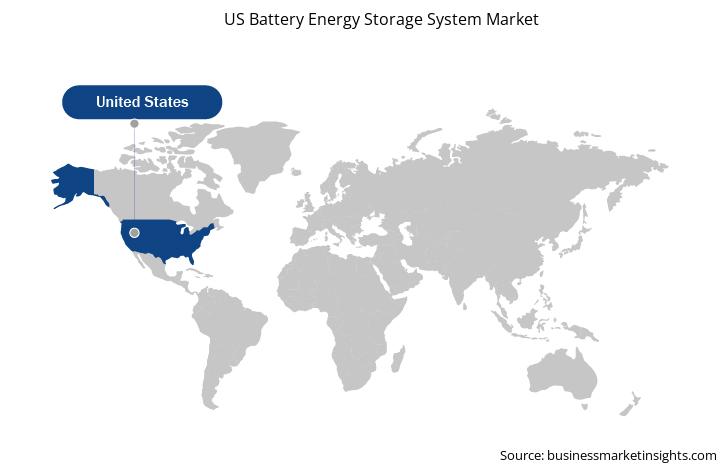The US battery energy storage system market size is projected to reach US$ 21,214.54 million by 2031 from US$ 6,274.28 million in 2023. The market is expected to register a CAGR of 16.5% during 2023–2031.
Rising population and growing urbanization are a few factors steering the Use of energy in the US. As per the US Energy Information Administration (EIA), US energy consumption is anticipated to grow through 2050 owing to economic and population growth. EIA also mentioned that US electricity end-use consumption was about 3.2% higher in 2022 than in 2021. Battery energy storage has the potential application as energy storage to be used in times of crisis or in remote or distant locations where power networks are not available. Furthermore, due to the increasing energy uncertainties worldwide, the US government is boosting the application of battery energy storage. For instance, in May 2024, Plus Power secured a US$ 82 million tax equity investment from bank Morgan Stanley for the Arizona-based 90 MW/360 MWh Superstition BESS project, which is anticipated to be operational in June 2024. In February 2024, RWE completed the construction of three new battery energy storage systems totaling 190 MW (361 MWh) in Texas and Arizona. Thus, the increase in energy demand fuels the development of the battery energy storage system market in the US.
In the US, the manufacturers must offer in-demand products such as advanced Li-ion battery energy storage systems products and invest in the research and development of high energy density batteries such as sulfur-based batteries. In addition, the new entrants operating in the market may face challenges in yield expansion as compared to established or experienced manufacturers in the country. Moreover, factors that are responsible for high-quality product manufacturing include technical expertise, government incentives, raw material costs, and others. The Inflation Reduction Act (IRA) production incentives offered by the government may reduce costs by more than 40% if the battery manufacturers or giga factories can get raw materials at lower prices and improve the production yield to 90%. In that case, IRA will help in reducing the battery cost to the Chinese product levels.
Vehicle electrification plays an important role in the carbon emission reduction goals set by the US. In general, vehicle electrification focuses on the electrically powered powertrain and its auxiliary systems, such as onboard and offboard charging systems and wireless power transmission. Vehicle electrification also includes many aspects of vehicle functions present in a traditional non-electric vehicle, including electronic power steering, electronic stability program, electronic traction control, intelligent lighting system, intelligent electromagnetic suspension, four-wheel drive, airbag delivery system, and others. The rise in demand and deployment of electric vehicles (EVs) across the US propels the requirement for vehicle charging infrastructure or electric vehicle charging stations. Hence, the power and transport sectors are expected to demand BESS to charge electric vehicles and enable a greater shift toward decarbonization of the two sectors in the coming years.
The US battery energy storage system market analysis is carried out by identifying and evaluating key players in the market. BYD Co. Ltd; Saft America Inc; CATL; Tesla Inc; Samsung SDI Co Ltd; Panasonic Holdings Corp; AES Corp; NextEra Energy, Inc.; Ameresco Inc.; ESS, Inc.; Siemens AG; EOS Energy Enterprises Inc; KORE Power Inc; General Electric Co; LG Chem Ltd.; SAFT Groupe SA; and ESS Inc. are among the key players covered in the US battery energy storage system market report. The report includes growth prospects in light of current US battery energy storage system market trends and driving factors influencing the market growth.
Strategic insights for the US Battery Energy Storage System provides data-driven analysis of the industry landscape, including current trends, key players, and regional nuances. These insights offer actionable recommendations, enabling readers to differentiate themselves from competitors by identifying untapped segments or developing unique value propositions. Leveraging data analytics, these insights help industry players anticipate the market shifts, whether investors, manufacturers, or other stakeholders. A future-oriented perspective is essential, helping stakeholders anticipate market shifts and position themselves for long-term success in this dynamic region. Ultimately, effective strategic insights empower readers to make informed decisions that drive profitability and achieve their business objectives within the market.

| Report Attribute | Details |
|---|---|
| Market size in 2023 | US$ 6,274.28 Million |
| Market Size by 2031 | US$ 21,214.54 Million |
| Global CAGR (2023 - 2031) | 16.5% |
| Historical Data | 2021-2022 |
| Forecast period | 2024-2031 |
| Segments Covered |
By Type
|
| Regions and Countries Covered | United States
|
| Market leaders and key company profiles |
The geographic scope of the US Battery Energy Storage System refers to the specific areas in which a business operates and competes. Understanding local distinctions, such as diverse consumer preferences (e.g., demand for specific plug types or battery backup durations), varying economic conditions, and regulatory environments, is crucial for tailoring strategies to specific markets. Businesses can expand their reach by identifying underserved areas or adapting their offerings to meet local demands. A clear market focus allows for more effective resource allocation, targeted marketing campaigns, and better positioning against local competitors, ultimately driving growth in those targeted areas.

The List of Companies - US Battery Energy Storage System Market
The US Battery Energy Storage System Market is valued at US$ 6,274.28 Million in 2023, it is projected to reach US$ 21,214.54 Million by 2031.
As per our report US Battery Energy Storage System Market, the market size is valued at US$ 6,274.28 Million in 2023, projecting it to reach US$ 21,214.54 Million by 2031. This translates to a CAGR of approximately 16.5% during the forecast period.
The US Battery Energy Storage System Market report typically cover these key segments-
The historic period, base year, and forecast period can vary slightly depending on the specific market research report. However, for the US Battery Energy Storage System Market report:
The US Battery Energy Storage System Market is populated by several key players, each contributing to its growth and innovation. Some of the major players include:
The US Battery Energy Storage System Market report is valuable for diverse stakeholders, including:
Essentially, anyone involved in or considering involvement in the US Battery Energy Storage System Market value chain can benefit from the information contained in a comprehensive market report.